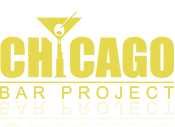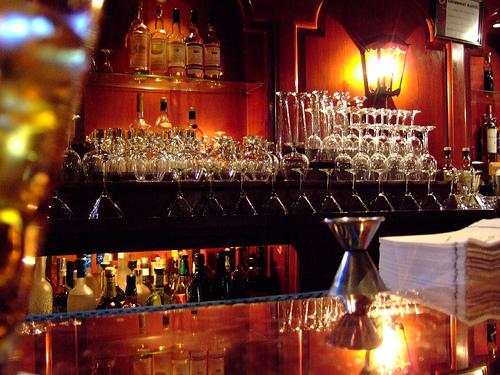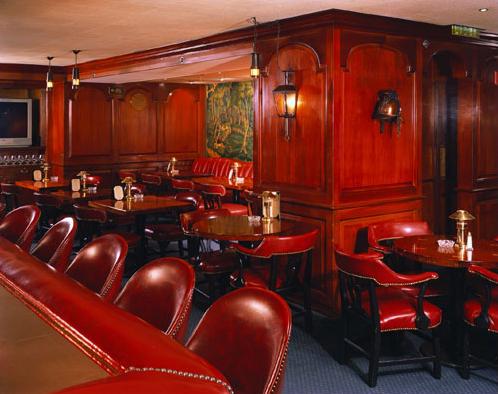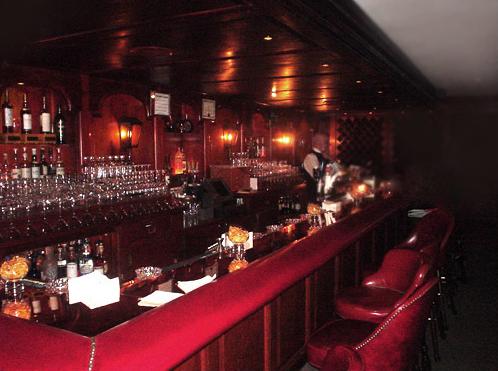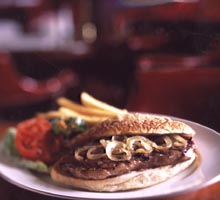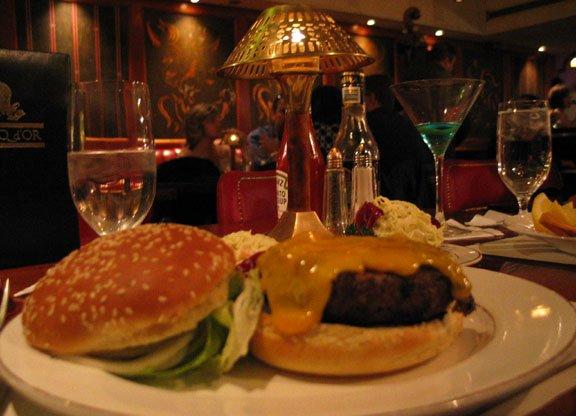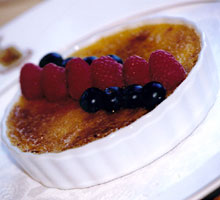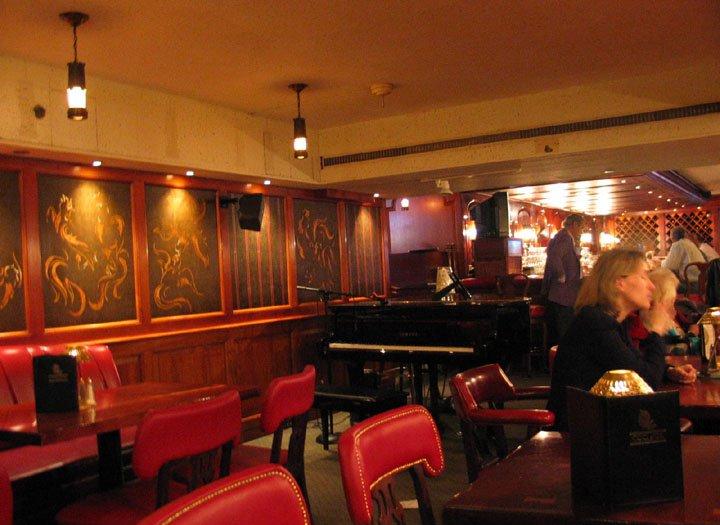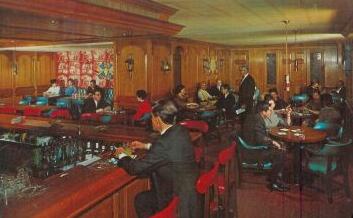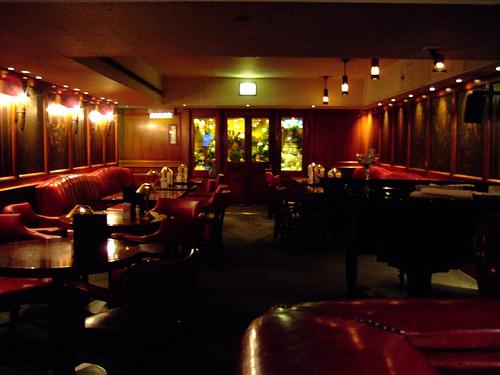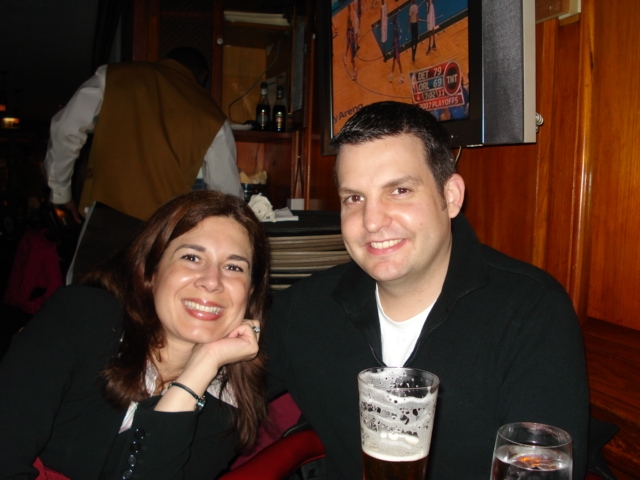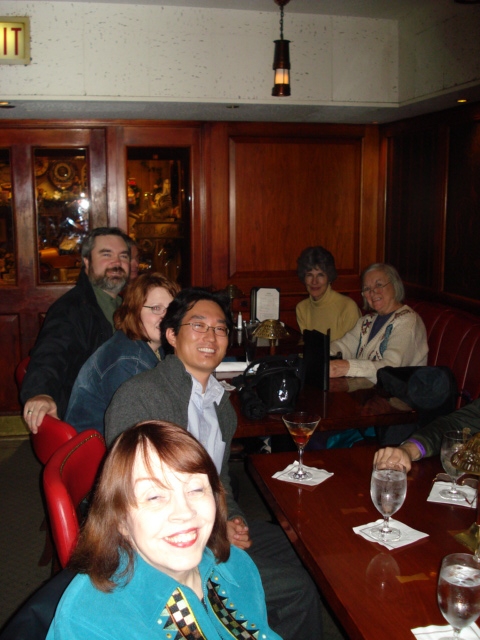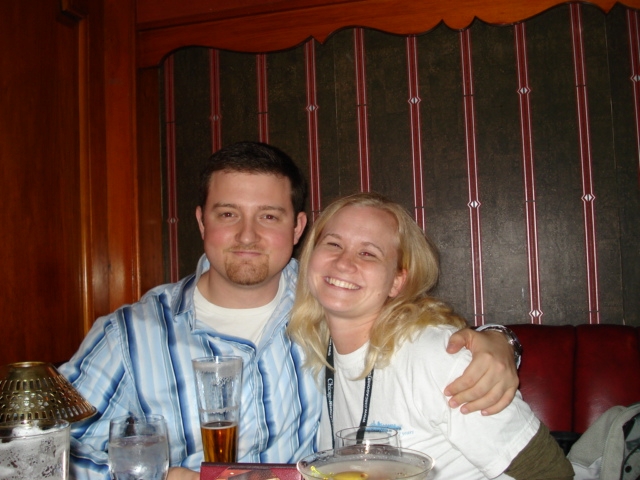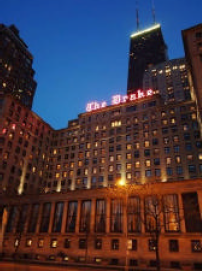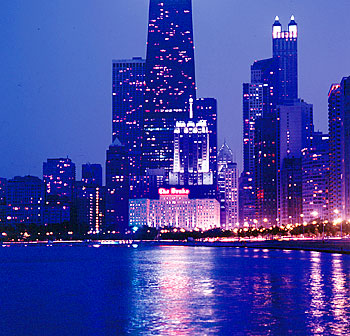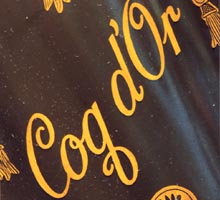 For years I have been intrigued by the red leather piano bar, Coq d’Or. Until my recent visit, I did not even realize that I had never stepped foot within the Drake Hotel, in which Coq d’Or can be found. As a resident of this great city, I rarely spend time in downtown hotels and, more importantly, I don’t happen to know anyone prestigious enough or having enough money to spend a night in the Drake… Regardless, my curiosity was finally satisfied recently, just prior to the second Chicago History Museum Pub Crawl, which made its second-to-last stop at Coq d’Or. What I found was a charismatic Chicago room that embodies the classiness of the hotel itself, which has drawn the likes of Emperor Hirohito of pre-war Japan, Winston Churchill, Queen Elizabeth II, Jawaharlal Nehru (first Prime Minister of independent India), Princess Diana, Joe DiMaggio and Marilyn Monroe, Eleanor Roosevelt, Walt Disney, and a host of U.S. presidents including Ronald Reagan. Coq d’Or became the second establishment in the city to serve alcohol following Prohibition and, since then, continues to offer an intimate space in which to enjoy an expertly poured martini, a cup of the legendary Bookbinder soup, and the sounds of jazz piano on weekends. All of the above makes Coq d’Or one of the best cocktail lounges in the city and is one of the few hotel bars with character in the entire world.
For years I have been intrigued by the red leather piano bar, Coq d’Or. Until my recent visit, I did not even realize that I had never stepped foot within the Drake Hotel, in which Coq d’Or can be found. As a resident of this great city, I rarely spend time in downtown hotels and, more importantly, I don’t happen to know anyone prestigious enough or having enough money to spend a night in the Drake… Regardless, my curiosity was finally satisfied recently, just prior to the second Chicago History Museum Pub Crawl, which made its second-to-last stop at Coq d’Or. What I found was a charismatic Chicago room that embodies the classiness of the hotel itself, which has drawn the likes of Emperor Hirohito of pre-war Japan, Winston Churchill, Queen Elizabeth II, Jawaharlal Nehru (first Prime Minister of independent India), Princess Diana, Joe DiMaggio and Marilyn Monroe, Eleanor Roosevelt, Walt Disney, and a host of U.S. presidents including Ronald Reagan. Coq d’Or became the second establishment in the city to serve alcohol following Prohibition and, since then, continues to offer an intimate space in which to enjoy an expertly poured martini, a cup of the legendary Bookbinder soup, and the sounds of jazz piano on weekends. All of the above makes Coq d’Or one of the best cocktail lounges in the city and is one of the few hotel bars with character in the entire world.
The Golden Cockerel and Executive Martini Coq d’Or, French for “golden cockerel” (a cockerel is a young rooster), is located on the first floor of the Drake Hotel, at the top of Michigan Avenue on the Magnificent Mile, and the bar is most easily accessible from the elegant southern entrance through the revolving door. As you pass through the southern threshold, Coq d’Or’s entrance is located just a few steps to your right. As you pass through the plate glass door framed in wood, you’ll find a somewhat narrow, hallway-like space filled with low-slung wooden tables with white tablecloths and red leather-padded chairs. A banquette of red leather lies against the western wall and below a mural of the French countryside sometime during the Napoleonic Era. Feel free to take whatever free table you like as there are is no hostess stand, or walk a little further and you can pull up a high-backed wooden barstool at the bar that runs half the length of the north wall.
Coq d’Or, French for “golden cockerel” (a cockerel is a young rooster), is located on the first floor of the Drake Hotel, at the top of Michigan Avenue on the Magnificent Mile, and the bar is most easily accessible from the elegant southern entrance through the revolving door. As you pass through the southern threshold, Coq d’Or’s entrance is located just a few steps to your right. As you pass through the plate glass door framed in wood, you’ll find a somewhat narrow, hallway-like space filled with low-slung wooden tables with white tablecloths and red leather-padded chairs. A banquette of red leather lies against the western wall and below a mural of the French countryside sometime during the Napoleonic Era. Feel free to take whatever free table you like as there are is no hostess stand, or walk a little further and you can pull up a high-backed wooden barstool at the bar that runs half the length of the north wall.
The bar’s specialty is the martini, highlighted by the “Executive Martini.” This four-ounce concoction is made with eight ice cubes and is poured from a brandy snifter when you order one on the rocks. It may appear pricey, but you’re actually getting 1.5 martinis. You can also get yourself a Red Apple Martini, “Drake Kiss,” or sample from a few of other drinks menu selections. Coq d’Or also serves the “Old Fashioned” made with sugar, bitters, fruit, bourbon and soda, as well as “The Perfect Manhattan” made with whiskey, dry and sweet vermouth, and shaken not stirred, just as Bond would have it if he ever got off martinis. A small variety of beer on tap and wine is also available, the latter of which is stored in the embedded wine rack in the eastern wall, just past the bar and next to the portal to the kitchen. The bar area is rather conducive for conversation, as you’re bound to find a few gentrified regulars and the two TVs above the bar have the volume turned low. After a few cocktails, the ladies will find their restroom embedded in the wood paneled southeast wall, whilst the gents will have to step out of Coq d’Or and out into the hallway, through the southern entrance, to find their restroom a few steps on the left.
 Across from the bar are more tables, another banquette and a second French mural. More seating can be found to the left of the bar in another long, narrow space filled with more low slung tables, wallpaper featuring the lounge’s namesake, and a piano. The current cabaret-style line-up consists of Judy Roberts and Greg Fishman, who play jazz and blues standards Thursday through Saturday, from 8:30pm to 12:30am. Many still remember when pianist Buddy Charles entertained guests at the Coq for more than 50 years until his retirement in 2001. Another entrance can be found at the west end of this area, giving you access to a small, marble-floored arcade of shops that make up the rest of the first floor at the Drake. You can also step up to a smaller seating area, just beyond the bar, that offers a trio of red leather crescent booths and a few more tables. This space also features the room’s largest television if you need to get your sports fix. Throughout Coq d’Or, a low, white drop-ceiling gives the place a more intimate feeling, while the dark, butternut wood-paneled walls, grayish carpeted floor and small, hanging orange lantern-like lights all contribute to the establishment’s warm atmosphere.
Across from the bar are more tables, another banquette and a second French mural. More seating can be found to the left of the bar in another long, narrow space filled with more low slung tables, wallpaper featuring the lounge’s namesake, and a piano. The current cabaret-style line-up consists of Judy Roberts and Greg Fishman, who play jazz and blues standards Thursday through Saturday, from 8:30pm to 12:30am. Many still remember when pianist Buddy Charles entertained guests at the Coq for more than 50 years until his retirement in 2001. Another entrance can be found at the west end of this area, giving you access to a small, marble-floored arcade of shops that make up the rest of the first floor at the Drake. You can also step up to a smaller seating area, just beyond the bar, that offers a trio of red leather crescent booths and a few more tables. This space also features the room’s largest television if you need to get your sports fix. Throughout Coq d’Or, a low, white drop-ceiling gives the place a more intimate feeling, while the dark, butternut wood-paneled walls, grayish carpeted floor and small, hanging orange lantern-like lights all contribute to the establishment’s warm atmosphere.
The Bookbinder and Other Sweet Surprises
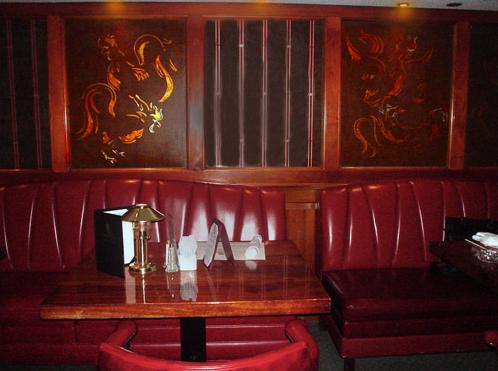 A somewhat limited menu is nonetheless highlighted by some notable dishes. To start with, there’s the New England Clam Chowder or, more importantly, the Bookbinder Soup – the Drake’s signature soup since 1967, made from red snapper with tomato stock served with a cruet or petite carafe of sherry and a roll with baked asiago cheese on the side. Two words: absolutely spectacular. I know it’s just soup, but the Bookbinder is easily the best soup I’ve ever had. There is some churn around the origin of Bookbinder Soup though and, as best as the Chicago Bar Project can tell, it was invented at Bookbinder’s Restaurant in Philadelphia and was originally made with snapping turtle and not red snapper (fish). As befits a lounge serving food, you can also start off with a shrimp cocktail, or a “Taco Martini” made from refried beans, salsa, guacamole and sour cream, served with tortilla chips. Chicken “drumettes” rather than wings are offered, tossed in a red hotsauce served with blue cheese dip, and you’ll also find chicken quesadillas, bruschetta, mini crab cakes, goat cheese brûlée, fried shrimp, nachos, and a hearty chili. Caesar salad with chicken or shrimp and the Cobb salad represent the more healthy options.
A somewhat limited menu is nonetheless highlighted by some notable dishes. To start with, there’s the New England Clam Chowder or, more importantly, the Bookbinder Soup – the Drake’s signature soup since 1967, made from red snapper with tomato stock served with a cruet or petite carafe of sherry and a roll with baked asiago cheese on the side. Two words: absolutely spectacular. I know it’s just soup, but the Bookbinder is easily the best soup I’ve ever had. There is some churn around the origin of Bookbinder Soup though and, as best as the Chicago Bar Project can tell, it was invented at Bookbinder’s Restaurant in Philadelphia and was originally made with snapping turtle and not red snapper (fish). As befits a lounge serving food, you can also start off with a shrimp cocktail, or a “Taco Martini” made from refried beans, salsa, guacamole and sour cream, served with tortilla chips. Chicken “drumettes” rather than wings are offered, tossed in a red hotsauce served with blue cheese dip, and you’ll also find chicken quesadillas, bruschetta, mini crab cakes, goat cheese brûlée, fried shrimp, nachos, and a hearty chili. Caesar salad with chicken or shrimp and the Cobb salad represent the more healthy options.
The entrées at Coq d’Or consist of fish & chips, lobster ravioli, fried perch, broiled whitefish tail, penne pasta, grilled jumbo shrimp, the curiously mundane turkey breast (though perhaps on the menu for those traveling away from home around Thanksgiving…), filet mignon, and “New Zealand Lamb Chops.” I was surprised to see that James Ward, food critic for ABC’s Chicago affiliate WLS TV, described the Classic Reuben as “luscious” and the Coq d’Or hamburger with its diced peppers and onions as “a singular perfection.” Coq d’Or also slings an all-day breakfast, featuring a *healthy* dose of corned beef hash topped with an order of eggs Benedict. My arteries are hardening just thinking about it… The dessert selection at Coq d’Or is comprised of the, “Double Chocolate Truffle Torte, Poached Pear, Raspberry Soufflé Glacé,” a mouthful just to say let alone eat, along with crème brülée with fresh berries, “Opera Cake” with Amaretto Soufflé Glacé, Poached Pear and Tiramisù Demi-Tasse with Orange Zest, key lime pie with coconut ice cream and mango-kiwi chutney, apple tart with cinnamon ice cream, bread pudding on crème anglaise, and finally, rice pudding. You’d be hard-pressed to find a more appealing selection of desserts anywhere else in Chicago… All of the above is served by waiters dressed in white shirts, gold vests and white aprons – all very well-mannered and prone to telling a few tall ones, as well as serving them. We were attended to by a Jamaican fellow that claimed Coq d’Or to be a mobster hangout, though there is no supporting evidence for this. Coq d’Or also features a variety of cigars for your after-dinner pleasure but, these days, you’ll have to smoke them outside while you banter with the bellhops. While most dinners will set you back about $35-50 per person, Coq d’Or does offer buy-one-get-one-free appetizers on Sunday, and they also feature a frequent diner card where you’ll get a $50 restaurant credit after 10 visits totaling $35 or more.
I Am Legend
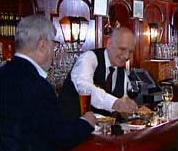 Coq d’Or not only opened on the day Prohibition ended the national tragedy of sobriety that lasted for 14 years, but also allegedly opened before the law was officially repealed in Illinois at 8:30pm on December 6, 1933. As such, Coq d’Or became only the second bar in town to obtain a liquor license from the City of Chicago. Can you guess who obtained the city’s first license? It was the semi-defunct Berghoff Restaurant. What was it like back then? According to the Coq d’Or menu, “The lines were so long that our bartenders only had time to pour whiskey at 40 cents a glass. Along with the rest of the city, we were ready, however, with an excess of 200,000 gallons of whiskey for the celebration that lasted until dawn.” The lucky 13-story Drake Hotel actually dates back further, having opened in 1920, along with the Cape Cod Room. According to Ewald Mietzner, the “bar captain” for 30 years, “Mr. Marshall [Benjamin Marshall, an early owner of the hotel] used to go to France quite a bit, and the Coq Rouge was a big bar in Paris, so he got the idea for a Golden Rooster here. People do murder the name sometimes, but I always tell them to think of a bottle of Coke and a door to a house,” (excerpt from “Bar’s Captain Ends ‘Diplomatic Service'” by Mary Knoblauch in the Chicago Tribune on June 8, 1976).
Coq d’Or not only opened on the day Prohibition ended the national tragedy of sobriety that lasted for 14 years, but also allegedly opened before the law was officially repealed in Illinois at 8:30pm on December 6, 1933. As such, Coq d’Or became only the second bar in town to obtain a liquor license from the City of Chicago. Can you guess who obtained the city’s first license? It was the semi-defunct Berghoff Restaurant. What was it like back then? According to the Coq d’Or menu, “The lines were so long that our bartenders only had time to pour whiskey at 40 cents a glass. Along with the rest of the city, we were ready, however, with an excess of 200,000 gallons of whiskey for the celebration that lasted until dawn.” The lucky 13-story Drake Hotel actually dates back further, having opened in 1920, along with the Cape Cod Room. According to Ewald Mietzner, the “bar captain” for 30 years, “Mr. Marshall [Benjamin Marshall, an early owner of the hotel] used to go to France quite a bit, and the Coq Rouge was a big bar in Paris, so he got the idea for a Golden Rooster here. People do murder the name sometimes, but I always tell them to think of a bottle of Coke and a door to a house,” (excerpt from “Bar’s Captain Ends ‘Diplomatic Service'” by Mary Knoblauch in the Chicago Tribune on June 8, 1976).
The clientele at Coq d’Or consists of a few regulars that may very well have been around for that first drink and who now reside in penthouses throughout the surrounding Gold Coast neighborhood, as well as hotel guests from around the world, and you’ll even find the wayward local bar reviewer… I found Coq d’Or to be quite upscale, though you will not feel out of place in casual attire, and with a similar vibe as another favorite of mine, the Redhead Piano Bar, located a bit further south in River North. With an excellent selection of food and drink, piano jazz on weekends and an atmosphere that harkens back to the 1930’s, Coq d’Or is most definitely a winner to whoever you are even though some describe the place as “stodgy.” Food critic James Ward went on to rate Coq d’Or with, “…a Bread rating of 7 for its food and booze, and a 7 for its Circuses,” (presumably on a 10-point scale). In recognition of its place in local history and culture, Brehon was featured on the second Chicago History Museum pub crawl, led by yours truly. The Chicago Bar Project recommendation: have a martini along with a cup of the splendid Bookbinder soup, and then head over to the Cape Cod Room for dinner so that you can see where Joe DiMaggio and Marilyn Monroe carved their initials into the bar and, in this way, you can enjoy both legendary establishments within the Drake Hotel, itself a national landmark. Or, you can put on your fancy shoes and stop by Coq d’Or after a performance at the Lyric Opera, a little further south in the Loop. Coq d’Or is open for both lunch and dinner, Monday through Saturday from 11:00am to 2:00am, and Sunday from 11:00am to 1:00 am. Food is served daily until midnight. For more information and the complete menu, check out the Coq d’Or website. Lovey!
Photos from the second Chicago History Museum Pub Crawl, Saloons of Old Chicago: The Gold Coast
